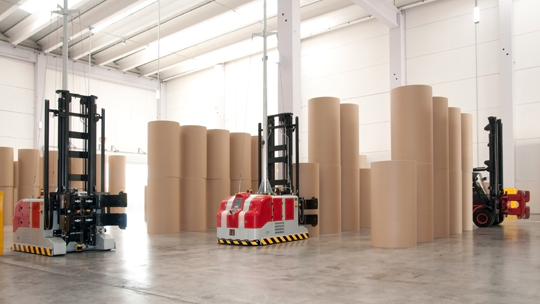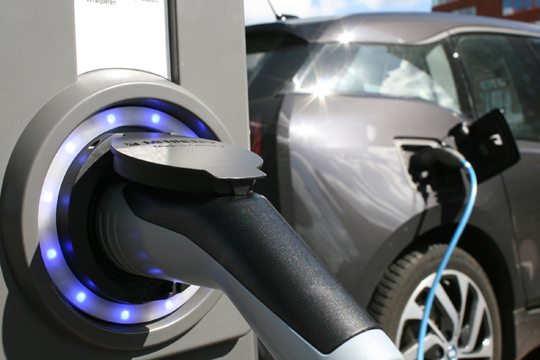Charging on the road
Freiburg, Aug 25, 2017
Whether it’s parking spaces, parking areas or a charging lane on the autobahn, Blue Inductive’s technology allows electric cars to recharge overnight or while they’re running – without plugging-in or the need for direct contact.

Blue Inductive’s new technology will first be applied to autonomous vehicles in industry and logistics. Photo: morenosoppelsa/Can Stock Photo
Driving in an electric car from Freiburg to Malaga, Spain, without stopping to recharge? Blue Inductive makes this fundamentally feasible. The young company, a spin-off from Freiburg’s Fraunhofer Institute for Solar Energy Systems (ISE), builds facilities that make recharging batteries without a cable or direct contact possible. The technology allows electrically powered vehicles to whizz down charging lanes on the autobahn and recharge their batteries at the same time. That would make a 2,000 kilometer journey to Malaga doable nonstop. “That’s in the future,” says Managing Director Johannes Mayer. The start-up is first aiming to serve mobile, autonomous industrial robots such as fork lifts or assembly platforms.
Charging power for 10 thousand smart phones
Essentially, Blue Inductive’s etaLINK-Technology does the same thing that induction stoves and cordless electric toothbrush and smartphone chargers do. They use a magnetic field to transmit electricity wirelessly. “There are already systems on the market,” says Mayer, “but they supply far less power.” EtaLINK can deliver up to 20 kilowatts (kW). Theoretically, that’s enough power to charge 20 thousand electric toothbrushes or 10 thousand smart phones at the same time – or a conventional electric car in less than one hour.
Besides, etaLINK is capable of transmitting electricity through the air. The donor and receiver can be a good 20 centimeters away from each other. That’s far more road clearance than most automobiles have. At any rate, fork lifts and mobile robots are closer to the ground. Despite the distance, little energy is lost in transmission. “Our systems achieve levels of efficiency of up to 95 percent. That puts them on par with the best charging devices that use cables,” emphasizes Florian Reiners, also a managing director at Blue Inductive. He continues, “When it comes to costs, devices with cables still have an advantage, but as soon as we begin to produce in bigger volumes, the price difference will even out.”
The power is only transmitted if receivers are there
The first product is set to go into series production at the start of 2018. It's a three kilowatt system for industrial robots. A receiving coil two centimeters thick and shaped like a record cover will be installed on the underside of the vehicle. There will also be a small box containing charger electronics. The donor coil on its stationary opposite number has a similar structure, but the box containing the electronics is about twice the size, about as big as a shoe box. The system will first be used in industrial plants. Later, it will also be installed in parking places for electric cars. “The stationary units recognize when a mobile partner is located over it,” says Mayer. Only then does the unit transmit electricity wirelessly.

In the long term, Blue Inductive’s etaLINK may make the need for cables and plugs to charge electric cars a thing of the past. Photo: estations/Fotolia
“The build resembles a classic, cabled charging device, where the electronics on the transformer are set apart from one another,” says Reiners. Like two of his founding colleagues, Johannes Tritschler and Benriah Goeldi, Reiner is a power electronics engineer. They are directing the development of hardware and software at Blue Inductive. Mayer is the fourth member of the founding quartet. He studied physics and economics. “We met each other during a research project on inductive charging of electric cars at the Fraunhofer ISE,” explains Reiners. The four-man team decided that the technology was far too exciting to see it end up in a drawer. The power founders took a close look at the market and discovered particularly large potential for supplying wireless recharging for mobile industrial robots.
Quartet set all their hopes on one card
It took almost a year for Blue Inductive to go from an idea to a company. “The process was really quite a struggle,” says Mayer. The team turned to the Founders Office of the University of Freiburg, where it learned of EXIST, a founders’ program of the German Ministry for Economic Affairs and Energy. “We bet everything on one card and quit our jobs before our application or financing were approved,” says Mayer. The rejection arrived in short order. The four founders had their backs to the wall. But they didn’t give up. The second EXIST application was approved and the fledgling start-up received investment funding from a business angel last year.
Mayer says the university’s support was helpful, but adds that Freiburg lacks sufficient space for start-ups. He argues that there should be a founders’ center or business incubator, explaining, “That would give the location a major boost. Young firms could share their experiences, locate there at a low cost and share common infrastructure for reception, telephone and internet. In the early phases, you count every cent.”
Making a contribution to electrification of transport
So why isn’t Blue Inductive aiming to conquer the electric car market right from the start? “Unified standards need to be defined first, so that later on, all the vehicles can use the charging infrastructure,” says Mayer. That’s why the company is focusing first on autonomous vehicles in industry and logistics – packing robots, warehouse vehicles or mobile assembly systems, for example. “There’s enormous interest,” says Mayer, pleased. In some cases, he adds, they even had demands for applications that Blue Inductive never thought of. “We are developing a whole family of systems for varying applications,” he says.
In the future, in addition to cars and buses, vans or even street cleaning machines will increasingly be electric and automated. Then at the latest, simple and automated charging solutions will be in demand. “We support the transition to electric transportation,” says Mayer, who drives an electric scooter. He hopes that Blue Inductive’s technology will make a meaningful contribution to the electrification of transportation down the road. He says that would definitively be a great success. “At start-ups, successes and setbacks come again and again in rapid succession,” says Johannes Mayer, “nevertheless, no one should be scared off by that. Start-ups are like roller-coaster riding, but we’re very satisfied about the way our enterprise has developed up to now.”
Jürgen Schickinger

